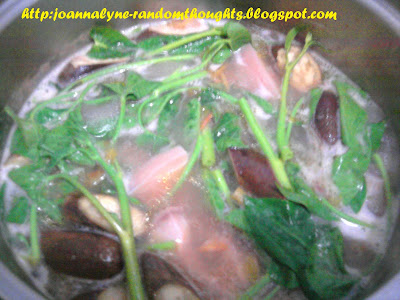Tonight's Dinner: Pork Sinigang (Pork in Sour Broth)
It is cold and windy so I decided to cook something that will warm the stomach... pork sinigang (pork in sour broth). Sinigang can be cooked in different ways and ingredients but generally, it is cooked using sour ingredient as the base like tomato, tamarind, camias (ginger lily) or miso.
 |
| Photo of my pork sinigang fresh from the pot. It's still simmering. |
Here are the ingredients:
1/2 kilo of pork liempo (pork belly) cut into small pieces or 1 kilo of pork ribs
2 cups of string beans, cut into 5" length
2 medium sized eggplant, cut diagonally into sections
2 medium size white radish, cut diagonally into sections
4 pieces okra, cut in halves
6 pieces gabi (taro), cut into small parts
1 bunch kangkong (river spinach) leaves, young parts are cut off the stem
2 medium onions, diced
4 medium tomatoes, diced
3 green chilis (Hungarian variety)
2 liters of water
1 pack sinigang mix (because squeezing the tamarind juice is so 1900's)
Here's how to cook it:
1. In a pot, put water and pork and let it boil for 5 minutes. While waiting for it to boil, mix the onions and tomatoes in a small bowl and then add at least two pinches of salt. Mix well (preferably using your clean hand) to let the juice come out. This is a trick that I have learned from my great great grandmother.
2. Put the onions and tomatoes and the sinigang mix into the pot and allow the pork to soften.
3. Add the taro, white radish and okra first since they take longer time to soften. After the taro, radish and okra have softened a bit, add the eggplant, string beans and chili. Do not overcook the vegetables.
4. Adjust the taste by adding salt. I personally like my sinigang sour so I don't put too much salt.
5. Turn off the heat before adding the river spinach leaves. Cover the pot. The steam will cook the leaves.
Sinigang is best served hot and with steamed rice. Yummy!
Trivia:
There are different types of sinigang (shrimp, beef, fish and even chicken) and regions in the Philippines have different styles in cooking it. But basically the ingredients are all the same except for when cooking the variation of sinigang--sinampalukang manok--which has ginger and shredded tamarind leaves to replace tomatoes. River spinach and gabi are also not common when cooking sinampalukang manok.



Comments
Post a Comment
I know you have something to say about this post, good or bad, I thank you! Do come back soon, I always find time to answer your comments.
XOXO
JOANNE